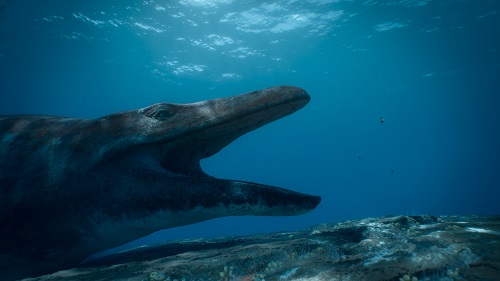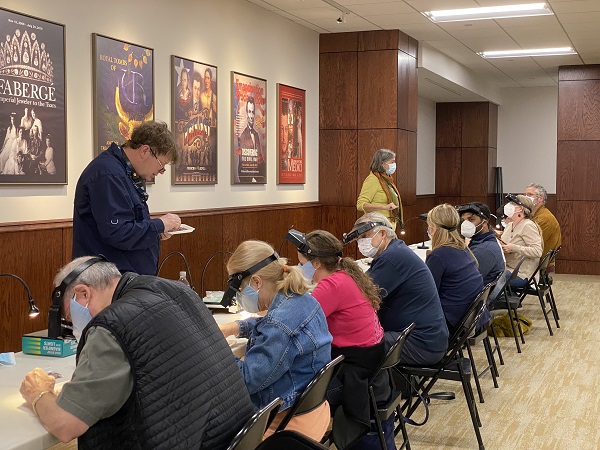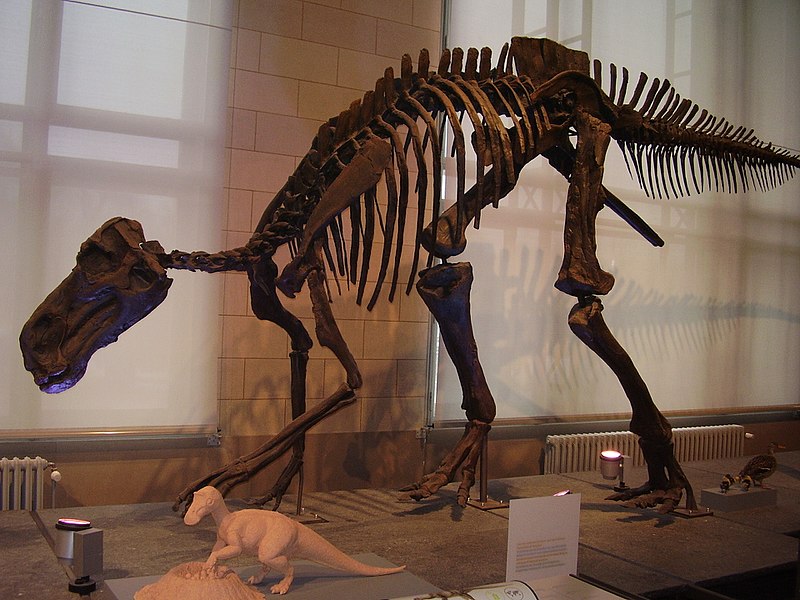
A piece of unapproved Ivy League art. Title: Podokesaurus holyokensis, Triassic/Jurassic Dinosaur, on the head of Michelangelo’s David. Material: Collage of Xerox images, clipped by scissors, Scotch taped together. Date: March, 1964. Artist: Robert Thomas Bakker, Yale freshman.
OMG I was such a dino-geek in college.
I had other interests — I was enraptured by sculpture and took the fabled freshman History of Art course. The collage shown here was taped together during the lectures on the Renaissance renewal of anatomically correct human form made famous by Greek sculptors. Last month, I found the collage in an old notebook, in the garage, under my copy of American Battleships, a Design History. (That’s for a future blog on the U.S.S. Texas.)
The tiny dinosaur is Podokesaurus — at the time, one of two famous bantam-weight predators of the Late Triassic and earliest Jurassic, the first chapters in dinosaur history. I knew the critter well because it was dug from the red beds of the Great Triassic/Jurassic Valley. Those fossil-rich sandstones and shales filled a rift valley that extended from Nova Scotia to the Carolinas. The rift was as big as the East African Rift we see today.
Smack dab in the middle of the Triassic/Jurassic Valley was New Jersey, where I grew up. Not far north from my house were the Palisades and Granton Quarry, where Triassic flying reptiles had been discovered, plus long-snouted phytosaurs like our HMNS Smilosuchus, plus dino footprints.
The reason I applied to Yale was mostly because it had a museum chock full of red beds specimens. When I visited in 1963, Yale had a cast of the podokesaur skeleton on display — sadly, the original was destroyed by fire 50 years previously. Next to the cast was a lively life-sized sculpture, done by the Yale curator Richard Swann Lull.
“Nifty!” I thought. “Art and paleontology combined! This is the place for me.” The Yale museum was super hospitable to freshmen. I got a job cleaning a Triassic red beds skull — not a dino, but a bizarre plant-eating reptile, woodchuck-sized, with spikes coming out of the head like a tricked-out horned toad. These fellows must have lived in colonies. A bunch were dug from a small area in New Jersey. Podokesaurs surely chased these prickly morsels.

Late Triassic, New Jersey. A colony of vegetarian Hypsognathus emerges from its burrow. Maybe they had been hiding from podokesaurs. Maybe they had been watching Jersey favorite The Sopranos on HBO. Texas was host to a similar reptile. Extra points if you can find it in our Triassic mural.
Freshman year also introduced me to the tradition of the “mixer” — parties where Yalies and young women from nearby colleges co-mingled. At a Mt. Holyoke mixer, I got an earful from female geology students who were steamed, justifiably, about gender bias. Old fogey Yale profs grumbled that “girls can’t lift heavy rocks […] can’t do serious fossil work.” Podokesaurus was a counterargument. It was discovered in 1910 by none other than Dr. Mignon Talbot, who was chair of the geology department. Talbot did her Yale Ph.D. on sea-lilies, crinoids, relatives of starfish that were abundant in Devonian rocks of New York State (we have some fab Jurassic crinoids in our hall). Dr. Talbot went on to become president of the college.
Even though, as college president, she out-ranked most of the Yale faculty of her time, they insisted on calling her “Miss Talbot” instead of “Dr. Talbot.” Yeesh. In 1965, the Yale director of graduate studies told me “Bob, we shouldn’t give Ph.D.s to girls … they’ll just get married and have babies.” Double yeesh!
But he didn’t know how famous her dinosaur would yet become! Dr. Talbot’s dinosaur influenced Jurassic Park — yes, that little novel (series) turned super-franchise.
In the article naming the beast, she noted that a similar-sized dino had just been excavated from the Late Triassic of Germany. It would be christened “Pro–compsognathus” in belief that the renowned Compsognathus of the Late Jurassic might be a descendant (it isn’t).
Since the one and only skeleton of the pro-compy is missing key parts, Dr. Talbot’s graceful Podokesaurus was used to fill in the blanks and give a general portrait of the fox-sized predators of the Late Triassic. Talbot’s creature gained more fame when it became the inspiration for an entire family, the Podokesauridae.
Later in the twentieth century more species were added to the podoke clan, including Coelophysis from New Mexico. The New York museums scored a mass grave of Coelophysis in the 1940s and 1950s: dozens of skeletons from adults two yards long to babies as small as Podokesaurus and Procompsognathus.

Proud members of the Family Podokesauridae. Coeolphysis grew to seven feet long. Check out the pubis in these guys!
IMPORTANT WARNING! The Jurassic Park franchise uses two names for tiny Triassic dinos: “pro-compy” and “compy”. There might be confusion among the dino-laity.
The true Compsognathus is Late Jurassic, with kin in the Early Cretaceous, and it doesn’t have podoke family values. As we’ll see in a bit, Crichton clearly meant his tiny carnivores to be classic Late Triassic/Early Jurassic carnivores — and that means podokesaurs.
The podokes had a near-monopoly in the meat-eating role in the Late Triassic/Early Jurassic. They were not only small and mid-sized carnivores, equivalent to kit foxes, coyotes and wolves, but they became the movers and shakers in the apex predator role. Big species attained lengths of 22 feet and weights approaching a ton — bigger than the biggest land meat-eaters today (grizzly and polar bears). All podoke species had that graceful build of Dr. Talbot’s Podokesaurus: supple neck, long torso, and outstandingly elongated tail.
And, for those of you who are pelvis-literate, you’ll notice another design feature: The pubis bone was outstanding in the forward slant and length.

Podoke attack! A 10-foot long podokesaur predator menaces the thin-necked herbivore Anchisaurus. Early Jurassic, Massachussetts, somewhere near Amherst College.
For Jurassic Park fans, Procompsognathus rings a bell. In Michael Crichton’s novel, the first dino we get to know is tweensey (but deadly) — a species identified as a pro-compy. These blood-thirsty characters are fond of jumping into perambulators and biting the faces of juvenile humans. They move in gangs. Crichton was dead-on here. Tracks from the Triassic/Jurassic do document podoke-packs, small carnivores cavorting in groups.
In the Jurassic Park movie, the pro-compys are unstoppable nasties who confront the gifted character actor, Wayne Knight (Newman) of Seinfeld fame. (Knight’s best known for portraying portly and disreputable men, but we should remember that he was a dashing romantic lead in Third Rock from the Sun.)
In Jurassic Park, Knight’s character learns a lesson — the hard way. At first, he insults the pro-compys and tries to scare them away. Then they flash their threat-collars, a device cribbed from the Australian Frilled-Lizard. Then they hurl loogies of what seems to be venomous schmaltz. Nice scene. Scary.
However, dino-nerds: watch out. There are no bones in the lizard collar so preservation in a skeleton would be unlikely. Plus, threat collars are unknown among the many dinos now represented by fossils with skin.
Plus, plus, no dino could spit. Spitting requires complex lip and face muscles of the sort a trombonist must have (didja know I was first-trombonist in the school band?). Reptiles can’t spit, birds can’t spit. Fossil dino faces show that the big, complicated lips just weren’t there.
Spitting cobras cheat. They don’t really spit. They have mouth muscles that squeeze the poison gland so the venom comes squirting out through the hollow fangs. Clever, but not a genuine spit.
Crichton used his dinos carefully. He fills Jurassic Park and Lost World novels with a lovely time-safari through the Mesozoic. He begins with the pro-compy, from the earliest slice of dino-time, about 210 million years ago. The long-necked brachiosaurs and stegos filled out the later Jurassic, some 145 million years ago. You could add a true Compsognathus here if you like. For the Early Cretaceous, 110 million years ago, we are given Deinonychus antirrhopus (labeled Velociraptor but actually Deinonychus). Triceratops, T. rex and the advanced ostrich-dinos fill out the last slice of Cretaceous, the Lancian Age, 66 million years ago. You can teach an entire paleo course with this fine selection of fossils.
Remember, in the books and movies the label “pro-compy” and “compy” is synonymous with the podokesaurs. Crichton did not intend his Triassic dino to be a Compsognathus, the Late Jurassic animal quite different in body plan from the podokesaurs. Here’s where dilophosaurs come in.
Dilophosaurus, sensu stricto, is a Southwest Early Jurassic apex meat-eater — a big brother of Coelophysis and Podokesaurus. The first specimens were announced by the Berkeley museum in the 1950s. Size: near maximum for the podoke family, nearly 2,000 pounds soaking wet. Our Chinese colleagues excavated a super diloph of the same body mass. In each and every bony bump, the dilophosaur is built to the same basic plan used for Coelophysis, et al. Big difference, besides size, is the side-by-side bone crests on the head.

The Berkeley diloph. Black and white photo shows first restoration of head without crests. Color snapshot shows the crests added. Michelangelo’s David in for scale. Do note that this is a biggish predatory dino.
In the books, Crichton does not describe any head ornaments for his pro-compys. The movie, on the other hand, gives the little fellows side-by-side crests, perfect miniatures of what true dilophs have. I go to screenings of the JP franchise every chance I get (“JP” is what we insiders call Jurassic Park). When I saw the 3D version on the HMNS Giant Screen, I was treated to massive vibrations that punctuated the scary parts.
“Dilophosaurus … DILOPHOSAURUS!” shouted the five-year-old sitting behind me. He was kicking the back of my seat with unconstrained enthusiasm. Can’t blame the kid. He had his plastic diloph in his lap, evidently a cherished pet and quite accurate in most anatomical details (neck and ankle too long, too skinny). The extreme close-ups of the pro-compy head on the screen did look diloph-y. But … the size was as wrong as wrong can be and still stay within the podoke family.
I was tempted to turn around and issue a correction: “Hey kid, that dino is a hundred times too small …” But I restrained myself. I estimated that the leader of the movie pro-compy pack was no more than 15 pounds, Boston Terrier-sized. With head crests, size matters. Small podokes don’t have much in the way of cranial protuberances. All the big crests are on big heads attached to big bodies.
And … there was something more, something missing from the schnoz in the movie compy. “No nose notch …” I said to myself. “Those guys in the movie have no nose notch … so … they aren’t members of the Family Podokesauridae!”
Notches below the hole for the nostril are a big deal in dinos and dino-kin. Land Croc-oids of the Triassic, second cousins of dinosaurs, usually are notched. But strong notches are rare amongst the carnivorous dinosaurians. T. rex is notch-less. So is Allosaurus and all the myriad raptors, from Micro-raptor to Meso-raptor to Mega-raptor. The bona fide Compsognthus is notch-less. The podoke family is the most consistently notched. Enjoy my own diagram of the Harvard skull from Coelophysis above. Please stare at the nose. There’s a notch here. Dilophosaurus has an even more emphatic notch.
No notch = no podokesaurid. Simple as that.
What about that long, slanty pubis, another hallmark of the podoke family? Study the movie dino as long as you like. You will find no unambiguous evidence of long, slanty pubic bones. None.
My conclusion: the movie artists did a great job with the pro-compys. They cobbled together a frightening chimaera from a bunch of critters, some lizards, some small meat-eating dinos, some big ones. These little dinos are the most imaginative, most mixed-up of all the JP creations. So enjoy them! But you cannot use the movie pro-compys to teach a lesson in dilophosaurs or any dilophosaur kin. The movie “compy/pro-compy” is NOT a crested podokesaur.
* Recently, some paleontologists have insisted using the name Family Coelophysidae to replace Podokesauridae, because we have so many skeletons of Coelophysis. These folks are well-meaning but, ahem, I am a Yalie and so I am sworn to defend the honor of Mt. Holyoke College and all its faculty and graduates. And its presidents. And its dinosaurs.











